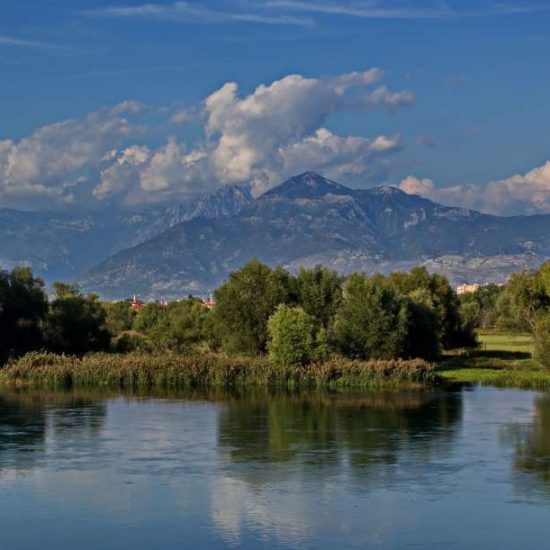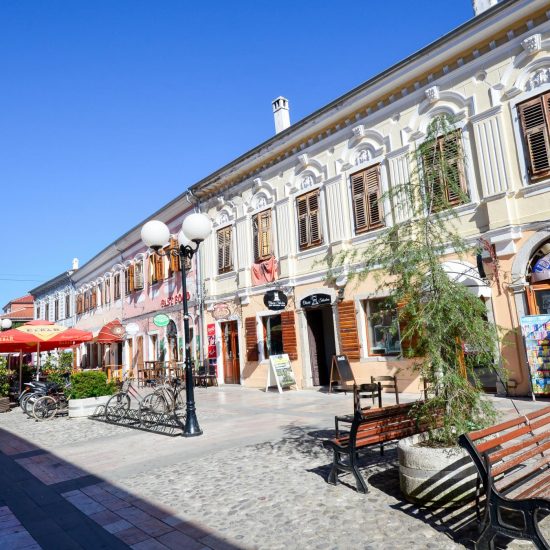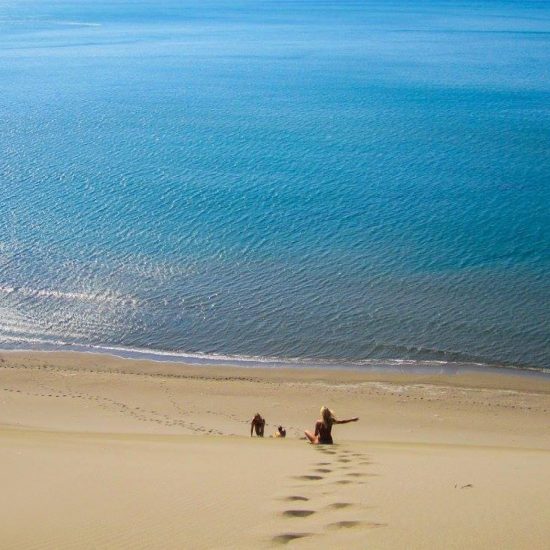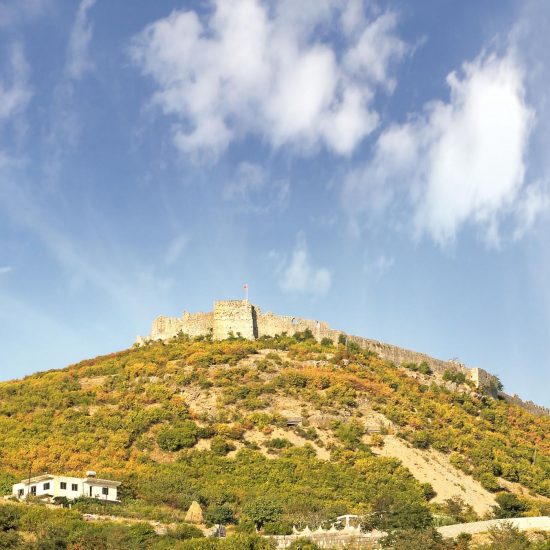Shkoder
Shkodra is one of the oldest cities in Albania, founded in the 4th century BC as the center of the Illyrian Labeat tribe. Throughout history, Shkodra has been occupied several times: first by the Romans (168 BC), then by the Serbs (1040), by the Venetians (1396) and finally by the Ottomans (1479). The city returned to Albanian control as the feudal Principality of Balshai in the 14th century and served as the urban center of Bushatlinj-Pashallek from 1757 to 1831. Shkodra is rich in cultural heritage; The city itself, as well as the people, are proud of the many artists, musicians, painters, photographers, poets, writers born here. Rozafa Castle is the main tourist attraction in Shkodra. Rising majestically on a rocky hill to the west of the city, the ledges and battlements paint a burning picture against the sunset. It is surrounded by the waters of three rivers; Drini, Buna and Kiri. Like the city it protected the castle is of Illyrian origin. According to historian Titus Leary, “this was the strongest area of Labets”. Like all ancient works, the castle has a popular local legend. Rozafa is the name of the bride of the youngest of the three brothers who originally built the castle. The three men worked tirelessly during the day, laying mortar and stone, but the walls always collapsed during the night. After consulting with a wise man, they learned that in order to drive out the evil that attacks their daily work and protect their friends and family with a strong castle that will last forever, one of their wives must be buried within the walls. The brothers made a terrible agreement not to warn their wives of this danger, and whoever brings her husband’s dinner food the next day will be sacrificed. However, the elder brothers broke their word, and only Rozafa came with food. Upon hearing the proclamation, she wept for her newborn son and husband, but allowed herself to become a living part of the walls so that the castle could be built. According to legend and local folklore, the limestone water flowing at the entrance to the castle is milk flowing from one of her breasts, which she asked to be left open so she could feed the baby. She begged that one leg and one arm be left free to rock her son’s cradle at night and comfort him during the day. Historians tell us the less magical and more scientific basis of the castle’s characteristics. It reflects the dominance of the Balshai family, but has gone through enough other periods of rule, each of which left its marks and marks on the territory, including clear Venetian highlights, some Ottoman architecture from the 16th and 17th centuries and even a few modifications from Rodina Bushatling in the 18th-19th century. Within the castle walls is a museum where the discerning antiquities lover can spend a comfortable day reading more about its history, and a restaurant has been added to showcase local food and traditional attire. In addition to the castle, you can also visit other attractions such as the Museum of City History near the stadium and the famous Marubi Photo Archive. Not far from the city is Lake Skadar, the largest lake in the Balkans with a surface area of 368 km2 (149 km2 in Albanian waters). The lake is distinguished by different shores: the southern shore is high and rocky, while the northern shore is low and swampy. For a cyclist or a recreational driver, the two main tourist centers are the cities of Shirokaya and Zogay, located on the coastline. Both villages, famous for their fishing, have restaurants serving the most popular local dish, baked carp. Every year on August 15, the Catholic pilgrimage of Shen Rrok, or Saint Rocco, in honor of the city’s historical protector, is celebrated in Shirokaya. Tradition states that after this date it is not recommended to swim in the waters of the lake. Skadra Lake has warm temperatures, absorbing sunlight for most days throughout the year. Swimming, sunbathing, and rowing are popular with tourists and locals alike. In addition to recreation, the lake is a very important ecosystem with 281 bird species and 45 fish species, including carp, eel. Velipoya beach is only 22 km away from the town of Shkodra. With an extremely high iodine content, the long coastline is famous for its healing sand, and many have dug into it to relieve bodily pain. In addition to swimming and fishing, the surrounding landscapes offer many fascinating natural landscapes worth seeing, such as the small island of Franz Josef, located at the mouth of the Buna River, near the border with Montenegro. Velipoya beach is only 22 km away from the town of Shkodra. With an extremely high iodine content, the long coastline is famous for its healing sand, and many have dug into it to relieve bodily pain. In addition to swimming and fishing, the surrounding landscapes offer many fascinating natural landscapes worth seeing, such as the small island of Franz Josef, located at the mouth of the Buna River, near the border with Montenegro. Velipoya beach is only 22 km away from the town of Shkodra. With an extremely high iodine content, the long coastline is famous for its medicinal sand, and many have dug into it, to relieve bodily pain. In addition to swimming and fishing,
Lying
The city of Lezha is located 47 km south of Shkodra. Another ancient Albanian city, it was first mentioned in historical documents under the name of Liss. In 1398, after the construction of the castle, the city was under the direct control of the feudal Leke Dukagjini family, but was eventually conquered by the Venetians. One of the most important historical events for the city, and for the whole of Albania, was the famous “Lezhany Assembly” on March 2, 1444, where, under the leadership of the national hero Skanderbeg, the Albanian principalities united against the Ottomans. Skanderbeg’s memorial grave is located here in the former Shen Kolli Cathedral where he was buried in 1468. Lezha Castle, another Illyrian landmark, sits on top of a hill overlooking the city below. Inside the castle, the ruins of an Ottoman mosque, a Roman arch and an Illyrian can be found. Just a short walk from the city, you will find the sandy Shengjin Beach at the foot of Mount Renchi. The community of Sunny Beach boasts a long and colorful history, known in past centuries as “caesarean section” and “nymphaeum”. Nearby is the mouth of the Drini River, providing an amazing ecosystem that is becoming more and more of a key attraction for international ecotourism. Also in the area is the Coone Vein National Park. With approximately 70 bird species, 22 reptile species, 6 amphibian species and 13 mammal species, it is a wide and varied protected habitat. One of the most pleasant surprises is the sandy island of Kune, which turns into a peninsula during low water. With 227 different plants growing on the island, the dense vegetation of Kuhne is a nesting site for many birds. The community of Sunny Beach boasts a long and colorful history, known in past centuries as “caesarean section” and “nymphaeum”. Nearby is the mouth of the Drini River, providing an amazing ecosystem that is becoming more and more of a key attraction for international ecotourism. Also in the area is the Coone Vein National Park. With approximately 70 bird species, 22 reptile species, 6 amphibian species and 13 mammal species, it is a wide and varied protected habitat. One of the most pleasant surprises is the sandy island of Kune, which turns into a peninsula during low water. With 227 different plants growing on the island, the dense vegetation of Kune is a breeding ground for many birds. The community of Sunny Beach boasts a long and colorful history, known in past centuries as “caesarean section” and “nymphaeum”. Nearby is the mouth of the Drini River, providing an amazing ecosystem that is becoming more and more of a key attraction for international ecotourism. Also in the area is the Coone Vein National Park. With approximately 70 bird species, 22 reptile species, 6 amphibian species and 13 mammal species, it is a wide and varied protected habitat. One of the most pleasant surprises is the sandy island of Kune, which turns into a peninsula during low water. With 227 different plants growing on the island, the dense vegetation of Kune is a breeding ground for many birds. Nearby is the mouth of the Drini River, providing an amazing ecosystem, which is becoming more and more of a key attraction for international ecotourism. Also in the area is the Coone Vein National Park. With approximately 70 bird species, 22 reptile species, 6 amphibian species and 13 mammal species, it is a wide and varied protected habitat. One of the most pleasant surprises is the sandy island of Kune, which turns into a peninsula during low water. With 227 different plants growing on the island, the dense vegetation of Kune is a breeding ground for many birds. Nearby is the mouth of the Drini River, providing an amazing ecosystem that is becoming more and more of a key attraction for international ecotourism. Also in the area is the Coone Vein National Park. With approximately 70 bird species, 22 reptile species, With 6 species of amphibians and 13 species of mammals, this is a wide and varied protected habitat. One of the most pleasant surprises is the sandy island of Kune, which turns into a peninsula during low water. With 227 different plants growing on the island, the dense vegetation of Kune is a breeding ground for many birds. With 6 species of amphibians and 13 species of mammals, this is a wide and varied protected habitat. One of the most pleasant surprises is the sandy island of Kune, which turns into a peninsula during low water. With 227 different plants growing on the island, the dense vegetation of Kune is a breeding ground for many birds. With 6 species of amphibians and 13 species of mammals, this is a wide and varied protected habitat. One of the most pleasant surprises is the sandy island of Kune, which during low water turns into a peninsula. With 227 different plants growing on the island, the dense vegetation of Kune is a breeding ground for many birds.





